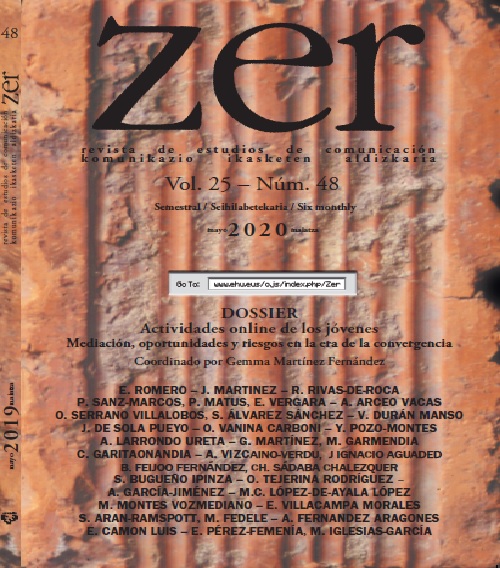Playing «YouTubers»: digital practices to prevent gender-based violence
##plugins.themes.bootstrap3.article.main##
##plugins.themes.bootstrap3.article.sidebar##
Sue Aran-Ramspott
Maddalena Fedele
Abstract
Recent studies point to YouTube as a fully integrated platform in the media life of youngsters and adolescents. This research project aims to establish if YouTube can be a tool for the prevention of gender violence among
this collective. A qualitative and participatory approach is applied in two age groups of adolescents and the methodological design has an exploratory phase in which we carry out seven focus groups; an applied phase of Service Learning (APS), in which participants prepare their own pieces for YouTube; and a phase of analysis of the resulting videos.
How to Cite
##plugins.themes.bootstrap3.article.details##
Youth, Literacy, Gender violence, Service-Learning.
Amnistía internacional (2009). Noticias que salvan vidas: manual periodístico para el abordaje de la violencia contra las mujeres. Buenos Aires: A.I. Argentina-Asoc. Civil Pro Amnistía. https://bit.ly/39rNdiI
Amnistía internacional (2019). Violencia de género en España. https://bit.ly/352SJVK. Consulta el 17 de diciembre de 2019.
Annette, J. (2005). «Character, civic renewal and service learning for democratic citizenship in higher education». British Journal of Educational Studies, 53, 3, 326-340.
Aran, S; De Puig, I. (2011). Violencia: tolerancia cero. Programa educativo: Secundaria. Barcelona: Obra social «la Caixa». https://tinyurl.com/rkd6uak
Aran-Ramspott, S., Fedele, M., & Tarragó, A. (2018). YouTubers’ social functions and their influence on pre-adolescence. [Funciones sociales de los Youtubers y su influencia en la preadolescencia]. Comunicar, 57, 71-80. https://doi.org/10.3916/C57-2018-07
Arandia, M., Alonso, M.J. y Martínez, I. (2010). «La metodología dialógica en las aulas universitarias». Revista de educación, 352, 309-329.
Araüna, N., Tortajada, I. y Willem, C. (2019). «Discursos feministes i vídeos de youtuberes: límits i horitzons de la politització jo-cèntrica». Quaderns del CAC 45, vol. XXII, 25-34.
Boyd, D. (2014). It’s complicated: The social lives of networked teens. New Haven (Connecticut): Yale University Press. https://bit.ly/2IxtlQI
Buckingham, D. (2003). Media education. Literacy, learning and contemporary culture. London: Polity Books.
Buckingham, D. (2008). Youth, identity and digital media. Cambridge, MA: The MIT Press.
Caballero-Gálvez, A., Tortajada, I. y Willem, C. (2017). «Autenticidad, marca personal y agencia sexual: el posfeminismo lésbico en YouTube». Investig. Fem (Rev.) 8 (2): 353-368.
Crenchaw, K.W. (1989). «Demarginalizing the intersection of race and sex: a black feminist critique of anti-discrimination doctrine, feminist theory and anti-racist politics». University of Chicago Legal Forum, 1989(1), 139-16. https://bit.ly/39tOQwC
Eyler, J. y Giles, D.E. Jr. (1999). Where’s the Learning in Service-Learning? San Francisco: J ossey-Bass Higher and Adult Education Series.
Fernández Alonso, M. (2003) Violencia doméstica. Madrid: Ministerio de Sanidad y consumo. https://bit.ly/39q0Y1v
Fernández-de-Arroyabe-Olaortua, A.; Lazkano-Arrillaga, I. y Eguskiza-Sesumaga, L. (2018). «Digital natives: Online audiovisual content consumption, creation and dissemination».
[Nativos digitales: Consumo, creación y difusión de contenidos audiovisuales online]. Comunicar, 57, 61-69. https://doi.org/10.3916/C57-2018-06
Ferrés, J. y Piscitelli, A. (2012). "Media competence. Articulated proposal of dimensions and indicators". [La competencia mediática: Propuesta articulada de dimensiones e indicadores]. Comunicar, 38, 75-82. https://doi.org/10.3916/C38-2012-02-08
Gewerc, A., Fraga, F. y Rodes, V. (2017). "Niños y adolescentes frente a la competencia digital. Entre el teléfono móvil, youtubers y videojuegos". Revista Interuniversitaria de Formación del Profesorado, 89, 171-186. https://bit.ly/2rBmpZf
Halliday, M. (2004). An Introduction to Functional Grammar. London: Edward Arnold.
Linares-Bahillo, E.; Aristegui-Fradua, I. y Beloki-Marañón, U. (2019). "YouTube, una plataforma para la (in)formación, relación, comunicación, diversión, y gestión de identidades (de género) en la natividad digital". Revista Mediterránea de Comunicación, 10(1), 55-70. https://doi.org/10.14198/MEDCOM2019.10.1.18
Livingstone, S. (2008). "Taking risky opportunities in youthful content creation: Teenagers' use of social networking sites for intimacy, privacy and self-expression". New Media & Society, 10(3), 393-411. https://doi.org/10.1177/1461444808089415
López-Vidales, N. y Gómez-Rubio, L. (2015). "Análisis y proyección de los contenidos audiovisuales sobre jóvenes y drogas en YouTube". Estudios sobre el Mensaje Periodístico, 21(2), 863-881. https://doi.org/10.5209/rev_ESMP.2015.v21.n2.50889
Montes-Vozmediano, M., García-Jiménez, A. y Menor-Sendra, J. (2018). "Teen videos on YouTube: Features and digital vulnerabilities". [Los vídeos de los adolescentes en YouTube: Características y vulnerabilidades digitales]. Comunicar, 54, 61-69. https://doi.org/10.3916/C54-2018-06
Obra social "La Caixa" (2006). Violencia: tolerancia cero. Curso de formación. La prevención de la violencia de género en el aula. https://bit.ly/39j25jo
Pérez-Torres, V., Pastor, Y. y Abarrou, S. (2018). "Los YouTubers y la construcción de la identidad adolescente". Comunicar XXVI (55), 61-70. https://doi.org/10.3916/C55- 2018-06
Pibernat, M. (2017). "¿Nuevas socializaciones, viejas cuestiones? Adolescencia y género en la era audiovisual". Investigaciones Feministas, 8(2), 529-544. https://doi.org/10.5209/INFE.54976
Puig, J. M. (2012). Compromís cívic i aprenentatge a la universitat: Experiències i institucionalització de l'aprenentatge servei. Barcelona: Graó.
Puig, J. M, Martín, X. y Batlle, R. (2008). Cómo iniciar un proyecto de aprendizaje y servicio solidario. Bilbao: Zerbikas.
Scolari, C. y Fraticelli, D. (2016). «Nuevos sujetos mediáticos en el ecosistema de medios».
V Congreso AsAECA, Buenos Aires.
Scolari, C. (2016). "Alfabetismo transmedia: estrategias de aprendizaje informal y competencias mediáticas en la nueva ecología de la comunicación". Telos: Revista de pensamiento sobre Comunicación, Tecnología y Sociedad, 193, 13-23. https://bit.ly/358g8oN
Simonsen, T. M. (2012). Identity formation on YouTube (Doctoral Dissertation). Aalborg: Aalborg University.
Tortajada, I. Caballero-Gálvez, A. y Willem, C. (2019). "Contrapúblicos en YouTube : el caso del colectivo trans". El profesional de la información, v.28, n.6, e280622. https://doi.org/10.3145/epi.2019.nov.22
Viñals, A.; Abad, M. y Aguilar, E. (2014). "Jóvenes conectados: Una aproximación al ocio digital de los jóvenes españoles". Comunication Papers, 3(4), 52-68. https://bit.ly/2KgpcOh
Wotanis, L. y McMillan, L. (2014). "Performing Gender on YouTube. How Jenna Marbles negotiates a hostile online environment". Feminist Media Studies, 14(6), 912-928. https://doi.org/10.1080/14680777.2014.882373

This work is licensed under a Creative Commons Attribution-NonCommercial-NoDerivatives 4.0 International License.
(c) UPV/EHU Press


 http://orcid.org/0000-0002-7334-0298
http://orcid.org/0000-0002-7334-0298